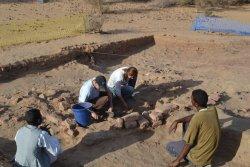University of Brighton
Source - http://popular-archaeology.com/issue/june-2013/article/kingdom-of-kush-iron-industry-works-discovered

Courtesy University of Brighton
New techniques developed at the University of Brighton to help archaeologists ‘see’ underground are starting to unlock the industrial secrets of an ancient civilisation.
The UCL Qatar research, investigating the iron industries of the Kingdom of Kush in Sudan, is attempting to identify 2000-year-old iron production workshops.
Working with colleagues from UCL Qatar, Dr Chris Carey, University of Brighton Senior Lecturer, has applied novel methods that have enabled archaeologists to map structures and deposits deep underground.
These underground maps have been used to uncover an iron production workshop complete with furnaces that were part of the economic engine room of the kingdom, which ruled northern Sudan and at certain times parts of Egypt between the 9th century BC and the 4th century AD. These workshops would have supplied the Kushites with iron tools and weapons and personal adornments.
The discoveries produced a Eureka moment for lead researcher Dr Jane Humphris (UCL Qatar). “Chris was able to tell us where to dig and how deep to dig and we soon found what we were looking for”.
“We had been searching for two years at other sites for workshops, without success, but this time was different. We uncovered a workshop with two furnace structures – only the third workshop of its kind ever to be found at the Royal City of Meroe.
“It was a very, very exciting moment. I texted Chris in Brighton immediately with the news.”
Dr Carey’s utilised gradiometry – a method that detects changes in magnetic fields and can pinpoint signs of human activities. Strong magnetic anomalies, for instance, suggest an iron ‘hot spot’, where iron was smelted. In this case the use of an additional method – electrical resistivity equipment which passes electrical current through the ground, allowed the depths of features such as slagheaps and buildings to be identified. Electrical resistance in the soil varies, and is affected by the presence of archaeological features. This second tool plotted the depth and volumes of the slag heaps.

Dr Carey (third from left) and Dr Humphris. Courtesy University of Brighton
Dr Carey visited the site to collect the data he needed and after analysing results in his laboratories in Brighton, he was able to send Dr Humphris detailed earth maps. He said: “Putting the two techniques together is a first for archaeo-metallurgy (the study of ancient metal production) and we are very excited by the success – no one has done this before. It is helping provide a holistic understanding of the industrial technologies this civilisation used and their impact on the society of the time.
“Already the results are beyond what we might have hoped for and this is the just the tip of the iceberg – and the University of Brighton is firmly embedded within this exciting project.”
The archaeological site at Meroe recently was declared a World Heritage Site but the researchers are only just beginning to understand the full significance industrial exploitation had on the empire.
Dr Carey said: “The Kingdom of Kush is famed for its pyramids and ancient temples but behind this complex society was an economy based on exploitation of raw resources and we are keen to learn more, including who was smelting the iron and what status they had in society. This economy is known to be archaeologically important but it has, as of yet, been little studied.”
Dr Carey and colleagues are now using laboratories at the University of Brighton’s School of Environment and Technology to analyse geochemical/isotopic samples from the dig to determine if other metals were smelted on the site. He will be spending a considerable amount of this time working on this project over the coming years.
Dr Humphris said Dr Carey’s work was integral to the project which is being assisted by other experts from a number of universities around the world. Dr Humphris said the project was providing educational, employment and training opportunities for local people as well.
For more information on the project go to: http://www.ucl.ac.uk/qatar/research/meroitic-iron-production-sudan
Source: Adapted and edited from a University of Brighton press release entitled Breaking new ground.